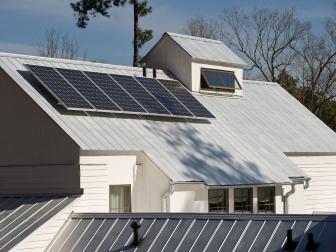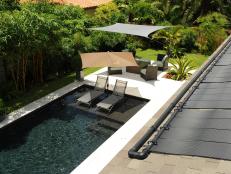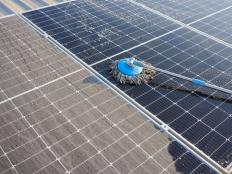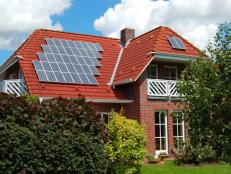Solar Power 101
Learn the basics of solar power and get tips for incorporating this abundant source of clean energy in your home.

With a historically low price tag and juicy incentives as further encouragement, more and more of us are going solar. According to the Solar Energy Industries Association, in the first quarter of 2022, solar accounted for half of all new electricity generation in the US, and a whopping 13% of US homes are expected to have a solar installation by 2030. Thanks to offsite options, solar power generation is now available to more American households than ever before. Read on to learn more about the transformative power of the sun and discover …
- How solar technology works
- The different types of solar modules and systems
- What's included in a system and how systems are sized
- Solar pricing and savings
- How to know if solar is right for your home
- Where to start
- Other ways to go solar
How Solar Power Generators Work

Shutterstock/Allahfoto
Solar panels and roofing products are made up of photovoltaic (PV) cells that create electricity in response to light. The DC current produced in the cell then passes through an inverter to make AC current that we can use to power the appliances in our homes.
The photovoltaic (PV) cell is the building block of solar energy. Photovoltaic describes a material that reacts to light energy (called photons) by producing electricity (volts). Inside the solar cell, silicon or other semiconductive material gets really excited in the presence of light and throws off electrons in response. Metal plates at the edges of that solar cell grab those electrons, which then flow down attached wires, creating an electric current.
At this point, what the solar cell has produced is direct current (DC) electricity, where the energy flows just one way. To make the current usable by our computers and coffee makers, the power must pass through a device called an inverter. The inverter takes the DC produced at the cell and converts it into the back-and-forth alternating current (AC) electricity that flows from our outlets.

Werner Slocum, NREL 66344
The majority of the homes in this neighborhood near Golden, CO, have rooftop solar installations. At the end of 2020, there were approximately 2.7 million residential PV systems in the United States. Since 2005, the number of photovoltaic systems has grown by approximately 32% per year (NREL).
Bedazzled Rooftops: Types of Solar Modules
The solar products we buy in the solar marketplace are generically called modules. Modules are simply a bunch of cells — sometimes a dozen, sometimes closer to 100 — grouped together. The solar module we’ve been used to for decades is the solar panel and it’s what many of us still think of when we hear solar power discussed — rows of gleaming panels mounted on rooftop racks. Residential panel systems are primarily installed on home rooftops, but also on carports, other standalone structures and (increasingly) on the ground. Right now, there are three major types of solar panels on the market: monocrystalline, polycrystalline, and thin-film. They vary in their composition, efficiency and durability. You may choose one over another because of price, aesthetics or home environmental factors, such as climate or the amount of space available for an installation.
Solar panels make up the majority of the market but, in recent years, an alternative solar module made of the same materials is gaining in popularity: the integrated solar shingle. Solar shingles are less bulky and conspicuous than panels and mount to your roof decking, not on a roof rack. There are a few subcategories sharing shelf space right now, and even though they are quite different products, they are all commonly referred to as solar shingles to make it fun.
- CertainTeed and other manufacturers make solar shingles and tiles that are sized like asphalt shingles or flat cement tiles and lie side-by-side on the decking with the rest of your roof.
- GAF Energy, in partnership with established roofing manufacturer GAF, has a product called Timberline Solar that pairs a powered section of flexible solar shingles with GAF’s conventional shingles on the remaining roof. The entire system is installed in one full-roof project by the same contractor.
- Tesla, Forward and Luma Solar sell whole-roof systems combining solar modules with non-solar roofing products that are nearly indistinguishable, allowing for a consistent appearance across the roof.
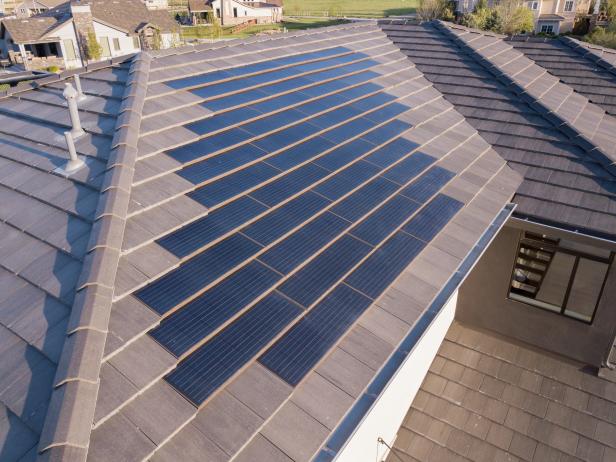
CertainTeed
The Apollo® Tile II solar roofing system from CertainTeed is designed to match the profile of flat concrete tiles, blending seamlessly into the roof plane for a clean look and protection from water intrusion.
Types of Solar Systems: What is the Grid?
Solar energy systems fall into one of three categories having to do with the system’s relationship to the local power grid. The grid is our electricity delivery system in this country, connecting households and other consumers with power providers and distributors.
- Standalone systems are isolated from the grid entirely and use batteries to store any excess power generated.
- Grid-connected systems generate power for the home, passing it back to the grid when there's excess and drawing power from the grid when solar energy isn't available.
- A hybrid system is grid-connected but also has a battery backup to store excess power.
According to EnergySage, a solar-comparison marketplace supported by the US Department of Energy, the vast majority of residential solar installations in this country are grid-connected, but consumers are more and more interested in energy storage systems. Standalone solar will remain the best choice for some homes: for example, remote residences with abundant sunshine and no power lines on their horizons.
What's in the Box
You can’t power a household on one solar module. Modules (panels or shingles) are grouped together in an array to meet your energy needs. A typical solar installation is made up of the modules and what those in the business call balance of system (BOS) equipment. This supporting cast includes the inverter(s), mounting hardware and wiring, safety equipment, meters and monitoring devices. Standalone system and hybrid system packing lists will add a battery (or several) and a device called a charge controller that manages the electricity from the solar panel, directing it to be used immediately in the home or sent to storage. A ground-mounted setup might have a tracking system that moves the panels through the day to maximize the sunlight. Occasionally, roof-mounted systems have this too.
Size is About Performance: How a Photovoltaic (PV) System is Designed
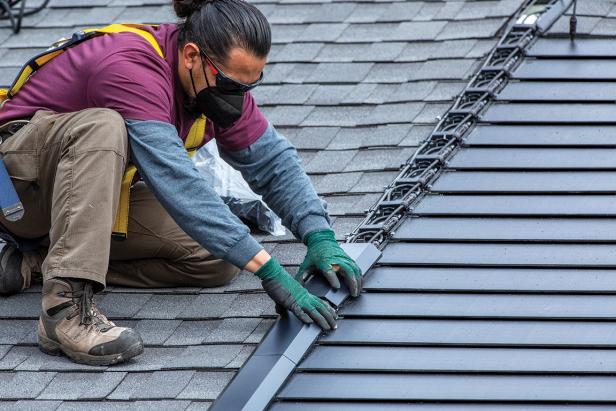
GAF Energy
Timberline Solar™ from GAF Energy boasts the world’s first nailable solar shingle. This system is installed with conventional roofing on the remainder of the roof by a single roofing contractor under one warranty.
There is no standard package in solar, and contractors design each system individually by considering three primary factors:
- The power rating of the panel or shingle — it represents the module's strength or capacity. It is the amount of electricity in watts (W) that the module produced during an hour of testing under ideal conditions in a lab. If you put 250W panels in a 20-panel array, you can tell your friends that you installed a 5 kilowatt (kW) system. Most solar panels available today have a power rating between 250W and 400W. Solar shingles vary as well: CertainTeed’s Apollo shingles and tiles are 70W; GAF Energy’s Timberline Solar shingle is 45W. Tesla’s Solar Roof module is 72W, according to EnergySage.
- The home’s solar resource or potential. This is a subjective measure of how much sunlight a system can expect to receive at your home. To determine it, solar contractors evaluate detailed location information like latitude and climate data but also the home orientation and roof pitch as well as tree or other shade coverage. Your roof isn’t a lab, and the sun hits every home uniquely and for a different amount of time throughout the day, depending not just on where you live in the country but your actual residence. For example, your sister’s northern Indiana farmhouse with nary a leaf in sight may have more light hitting it than your pine forest cabin in sunny Southern California. That’s where solar resource comes in — predicting system performance. Contractors use solar resource to estimate of how much energy your system will produce in kilowatt hours (kWh), relative to system size in kilowatts — they call this the production ratio. Solar resource accounts for how the same 5kW system might produce roughly 6,600 kWh of electricity in Boston annually and 8,000 kWh in Los Angeles (EnergySage).
- The household’s annual household electricity usage. According to the US Energy Information Association, the average electricity consumption for a US household in 2020 was 10,715 kWh. This figure tells you how much power you would normally buy from the utility and will help you predict how big of an impact a system could have on your need for utility power. You can find your number by checking your utility bills.
Solar Pricing and Savings
The upfront cost of a PV system depends on a bunch of factors. In one column is the equipment itself — including the type of module, the brand and its efficiency — as well as the system size and connectivity to the grid. But that’s less than half of the final bill, with design, installation, permitting, interconnection all weighing in mightily. So, your region and home peculiarities can really impact the price you pay. Before incentives, EnergySage estimates that a 10kW solar panel installation in the US costs about $27,700 and Tesla’s whole-roof system could run $60,000 to $75,000. The integrated solar shingle products arrive somewhere in the middle.
Incentives reducing the price include grants, rebates and tax credits available to purchasers of PV systems. Some of these perks can be massive. For example, from now through the end of 2032, you can deduct 30 percent of the installed price of a system from your federal income taxes, if you pay enough in taxes to reduce your burden to this degree.
How you pay matters, too. A lot. Nowadays, you can buy a system outright, or you can lease or finance the purchase, shifting the upfront investment to monthly payments over many years. With traditional financing or solar loans (low-interest rate loans), you own the system when you’ve paid it off but not so with leasing. With leasing, you are paying monthly on a long-term contract for a product that you never own, which also eliminates your opportunity for incentives.
For those buying the system outright, the initial outlay is only half the story: A well-planned PV system should pay for itself in energy savings during the first several years of ownership. We discuss the financial side of solar in our article on solar pricing.
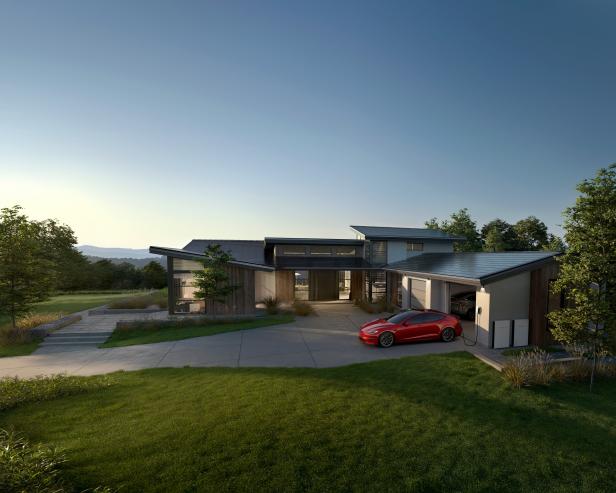
Tesla, Inc.
Solar Roof by Tesla is a combination of glass solar tiles and architectural-grade steel tiles that are indistinguishable for a seamless look.
Is Solar Power Generation Right for You?
In a Pew Research Center survey conducted in 2019, almost half of respondents said that in the past year they gave serious thought to adding solar panels to their home. There are excellent reasons to consider solar power besides saving money: energy independence, grid frustrations, the planet and household environmental concerns, to name a few. That said, for most solar seekers — especially those who plan on purchasing a system outright — the financial aspect of the decision is hugely important.
The first question you should ask is whether your home is solar-capable and to what extent. Roof-mounted solar panels need to be installed on a roof in good condition. Solar shingles — whole roof or part — make the most sense when your roof is ready for replacement. Oh, and about that roof? If there’s moss growing on it, you may not be the best candidate for rooftop solar, but your sunny backyard could be perfect for a ground-mounted solar panel system. Many solar adopters have the goal of generating enough electricity to meet the household’s needs in full, but these desires could be constrained by a small amount of sun-drenched space or other factors.
Then, with the wide range of products on the market and varying recommendations between contractors, it can be a challenge to compare one offering to another. Shingles are more aesthetically pleasing than panels, but they usually arrive with a higher cost than panel systems that produce the same amount of power.
For insight into some of the complexities of a solar purchase, we reached out to Dr. Becca Jones-Albertus, Director of the Solar Energy Technologies Office at the US Department of Energy. To start, the hefty price tag on solar shingles shouldn’t surprise us, apparently. Dr. Jones-Albertus explains that the technology is relatively new, adding that the price may come down as it becomes more common. Besides, she says, “Solar shingles combine two functions in one — roofing and solar — and are likely to therefore be higher cost than solar panels alone.” She finds solar shingles well-suited for new construction and says they may also be cost-effective for homeowners ready for a roof replacement.
But the upfront price of any system, Dr. Jones-Albertus reminds us, is only part of the equation: The power company itself is a major factor in the financials. She says, “Your savings also depend on the electricity rates set by your utility and how much the utility will compensate you for any excess solar energy you send back to the grid.” She adds that in some cities, solar is already cost competitive with electricity sold by the local utility.
In terms of trying to get all our electricity needs met by solar, Dr. Jones-Albertus makes the point that a solar system doesn’t have to be an all-or-nothing decision. She says, “The amount of power generated by a rooftop solar system varies by household, but consumers can save money on their electricity bills even if solar covers only part of their overall usage.” Our electricity needs in this country are expected to go up, not down, Dr. Jones-Albertus says. She references the Solar Futures Study, an investigation of solar energy’s role in a carbon-free electric grid produced by her office and the National Renewable Energy Laboratory. This study revealed that our annual electricity usage is expected to rise 30% from 2020 to 2035. Why? Households are shifting fuel-powered elements to electric, like heating and cooling, as well as transitioning from gas-powered to electric cars.
Ready to Start?
The free internet tool Google Project Sunroof can help you answer many of the initial questions about your home in one go. It analyzes your roof data to determine solar resource and then factors in your average power bill and what it knows about electricity rates in your area. If a PV system makes sense for your home, the calculator will recommend a size, estimate a price and let you know how long it might take to pay it off in energy bill savings.
If the numbers look good for you, then it’s time to call in a few knowledgeable and experienced PV professionals for quotes to compare. Word of mouth may lead you to a reputable installer, but if you’re the trailblazer in your neighborhood or friend group, start with your utility provider or a trusted local construction contractor for recommendations. You can also find local installers with reviews of their services using the EnergySage search tool. If solar isn’t yet popular where you live, you may find it difficult to get competitive pricing and find experienced installers. Solarize campaigns encourage solar adoption in communities by linking would-be solar adopters together so they can benefit from group purchasing power and know-how, lowering the price of high-quality installations.
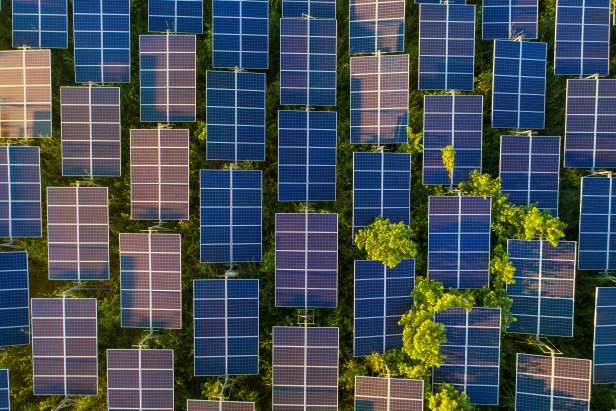
Shutterstock
Solar panels can be roof-mounted or ground-mounted. Some community solar installations take the form of a solar farm of ground-mounted panels on a large expanse of land. Community solar farms allow individuals to take advantage of solar power generation without putting systems on their homes, making it available to renters and condo residents, too.
If Solar Power Generation Isn’t Right for Your Home
Don’t fret! There are a couple of options for those of us who have it made in the shade to still soak up some sun. Community solar projects allow everyone from forest dwellers to condo residents and renters to avail of solar benefits without the gleaming rooftop. Community solar projects are operated by utilities, businesses, neighborhood groups and condo associations and take different forms. The basic idea is you buy in or subscribe to a share of a solar installation and then receive a portion of the energy production rewards. Visit the community solar section of EnergySage to see if there's one near you.
Also, utilities across the country offer renewable power programs that allow customers to participate in the environmental benefits of solar power generation for a small fee. Usually sporting the word green in the title, these programs allow you to buy solar electricity from the utility in blocks or by matching your monthly electricity usage. So, you’re not getting free power, but you are requesting that the utility use renewable power generation to the tune of your purchase. In another program available in a handful of states called Community Choice Aggregation (CCA), residents of a town or city are able to band together to choose the supplier of their electricity and that supplier can be a renewable power provider. The EPA has a list of states where CCA programs are available now and where they are coming soon.
Dr. Jones-Albertus explains that these programs incentivize the creation of large-scale solar farms or other renewable energy. “DOE is working toward a fully decarbonized electricity grid by 2035, when all power would come from renewable and other clean energy sources,” she says.
Maybe your home isn’t right for solar power generation, or maybe it just isn’t right now. Solar roofing resides in an exciting research category called building-integrated photovoltaics, modules that are built into the fundamental aspects of our homes — the roof, walls and windows. And in terms of technology research, windows are the next big thing, with solar glass and solar blinds under development.
Also, we have covered using the sun to generate power, but there are several other solar strategies that reduce the need for electricity. Using the sun’s thermal energy to heat water and air, passive design in our homes and gardens and incorporating solar lighting inside and out are all ways to make a huge impact.
How Much Does Solar Power Cost?
If the sun shines brightly at your home, you could be making your own electricity instead of paying for it.






